|
c:
Abbreviation for the speed of light. 299,792.5 km per second in a
vacuum. |
|
C:
Abbreviation for Celsius. Measure of temperature where pure water
freezes at 0° and boils at 100°.
|
|
Cable:
One or more
optical fibers
enclosed, with
strength members,
in a protective covering.
|
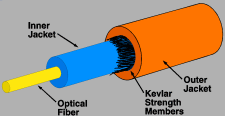 |
|
Cable Assembly:
A cable that is connector terminated and ready for installation.
|
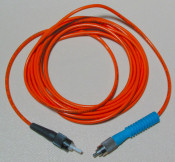 |
|
Cable Plant:
The cable plant consists of all the optical elements including fiber,
connectors,
splices,
etc. between a
transmitter
and a receiver.
|
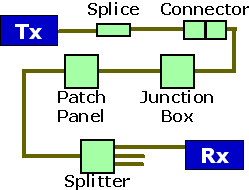
|
|
Cable Television:
Communications system that distributes broadcast and non-broadcast
signals as well as a multiplicity of satellite signals, original
programming and other signals by means of a coaxial cable and/or optical
fiber.
|
|
Carrier-to-Noise Ratio
(CNR):
The ratio, in decibels,
of the level of the carrier to that of the noise in a receiver’s IF
bandwidth before any nonlinear process such as amplitude limiting and
detection takes place.
|
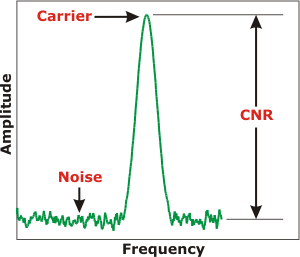
|
|
CATV:
Originally an abbreviation for community antenna television; the term
now typically refers to
cable television.
|
|
C-Band:
The wavelength range
between 1530 nm and 1562 nm used in some
CWDM
and
DWDM
applications.
|
|
CCIR:
Abbreviation for Consultative Committee on Radio. Replaced by ITU-R.
|
http://www.itu.int |
|
CCITT:
Abbreviation for Consultative Committee on Telephony and Telegraphy.
Replaced by ITU-T.
|
http://www.itu.int |
|
CCTV:
Abbreviation for closed-circuit television. An arrangement in which
programs are directly transmitted to specific users and not broadcast to
the general public.
|
|
CD:
Abbreviation for compact disk. Often used to describe high-quality
audio, CD-quality audio, or short-wavelength lasers; CD Laser.
|
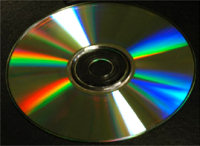
|
|
CDMA:
Abbreviation for code-division multiple access. A coding scheme in which
multiple channels are independently coded for transmission over a single
wideband channel using an individual modulation scheme for each channel.
|
|
|
Center Wavelength:
In a laser,
the nominal value central operating wavelength. It is the wavelength
defined by a peak mode measurement where the effective optical power
resides (see illustration). In an LED,
the average of the two wavelengths measured at the half amplitude points
of the power spectrum.
|
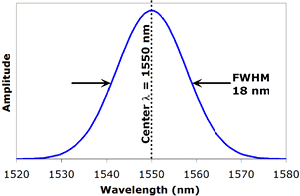
|
|
Central Office
(CO):
A common carrier switching office in which users’ lines terminate. The
nerve center of a communications system.
|
|
CGA:
Abbreviation for color graphics adapter. A low-resolution color standard
for computer monitors.
|
|
Channel:
A communications path or the signal sent over that path. Through
multiplexing
several channels, voice channels can be transmitted over an optical
channel.
|
|
Channel Capacity:
Maximum number of
channels
that a cable system can carry simultaneously.
|
|
Channel Coding:
Data encoding and
error correction
techniques used to protect the integrity of data. Typically used in
channels with high bit error rates such as terrestrial and satellite
broadcast and videotape recording.
|
Chirp:
In laser diodes, the shift of the
laser’s
center wavelength
in response to modulation. While changing the modulation current of the
laser is usually thought to create amplitude modulation (AM),
chirp introduces a frequency modulation (FM)
component as well. The illustration shows a laser driven at three
current levels.
|
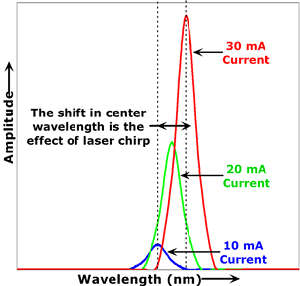
|
| Chromatic
Dispersion:
Reduced fiber bandwidth caused by different wavelengths of light
traveling at different speeds down the
optical fiber.
Chromatic dispersion occurs because the speed at which an optical pulse
travels depends on its wavelength, a property inherent to all optical
fiber. May be caused by
material dispersion,
waveguide dispersion,
and
profile dispersion. |
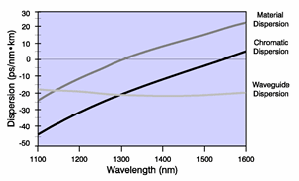
|
|
Circulator:
Passive three-port devices that couple light from Port 1 to 2 and Port 2
to 3 and have high isolation in other directions.
|
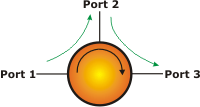
|
|
Cladding:
Material that surrounds the
core
of an optical fiber. Its lower
index of refraction,
compared to that of the core, causes the transmitted light to travel
down the core.
|
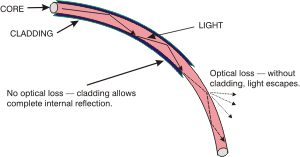
|
|
Cladding Mode:
A
mode confined to the cladding; a light ray that propagates in the
cladding.
|
|
Cleave:
The process of separating an
optical fiber
by a controlled fracture of the glass, for the purpose of obtaining a
fiber end, which is flat, smooth, and perpendicular to the fiber axis.
|
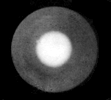 |
|
cm:
Abbreviation for centimeter. Approximately 0.3937
inches.
|
|
CMOS:
Abbreviation for complementary metal oxide semiconductor. A family of
IC’s.
Particularly useful for low-speed or low-power applications.
|
|
CMTS:
Abbreviation for cable modem
termination system.
|
|
Coarse
Wavelength-Division Multiplexing (CWDM):
CWDM allows eight or more channels to be stacked in the 1550 nm region
of optical fiber, the C-Band.
Extended CWDM can include as many as 18 channelsranging from 1270 nm to
1610 nm.
|
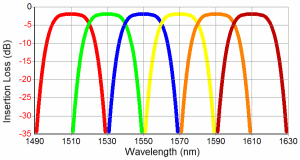
|
|
Coating:
The material surrounding the
cladding
of a fiber. Generally a soft plastic material that protects the fiber
from damage.
|

|
| Coaxial Cable:
1) A cable consisting of a center conductor surrounded by an insulating
material and a concentric outer conductor and optional protective
covering. 2) A cable consisting of multiple tubes under a single
protective sheath. This type of cable is typically used for CATV,
wideband, video, or RF applications. |

|
|
Coder:
A device, also called an encoder that converts data by the use of a
code, frequently one consisting of binary
numbers, in such a manner that reconversion to the original form is
possible. |
|
Coherent Communications:
In fiber optics, a communication system where the output of a local
laser oscillator is mixed optically with a received signal, and the
difference frequency is detected and amplified. Essentially using an
optical signal as an FM signal, i.e. modulating the wavelength (color)
of the light.
|

|
|
Color Subcarrier:
The 3.58 MHz signal which carries color information in a TV signal.
|
|
Composite Second Order
(CSO):
An important distortion measure of analog CATV systems. It is mainly
caused by second-order distortion in the transmission system.
|
|
Composite Sync:
A signal consisting of horizontal sync pulses, vertical sync pulses, and
equalizing pulses only, with a no-signal reference level.
|
|
Composite
Triple Beat (CTB):
An
important distortion measure of analog CATV systems. It is mainly caused
by third-order distortion in the transmission system.
|
|
Composite Video:
A signal which consists of the luminance (black and white), chrominance
(color), blanking pulses, sync pulses, and color burst.
|
Compression:
1) A process in which the dynamic range or data rate of a signal is
reduced by controlling it as a function of the inverse relationship of
its instantaneous value relative to a specified reference level.
Compression is usually accomplished by separate devices called
compressors and is used for many purposes such as: improving
signal-to-noise ratio,
preventing overload of succeeding elements of a system, or matching the
dynamic ranges of two devices. Compression can introduce
distortion,
but it is usually not objectionable. 2) Referring to a variety of
digital techniques for reducing the size of a digital data set, e.g.
MPEG-2 video compression.
|
|
Concatenation:
The process of connecting pieces of fiber
together. |
|
Concentrator:
1) A functional unit that permits
a common path to handle more data sources than there are channels
currently available within the path. Usually provides communication
capability between many low-speed,
asynchronous
channels and one or more high-speed, synchronous channels. 2) A device
that connects a number of circuits, which are not all used at once, to a
smaller group of circuits for economy.
|
|
Concentricity:
The measurement of how well-centered the
core
is within the cladding.
|
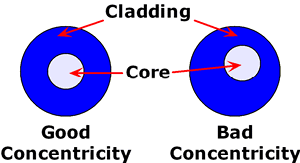
|
|
Connector:
A mechanical or optical device that provides a demountable connection
between two fibers or a fiber
and a source
or detector.
|
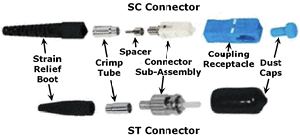
|
|
Connector Plug:
A device used to terminate an electrical cable (illustrated) or an
optical cable.
|

|
|
Connector Receptacle:
The fixed or stationary half of a connection that is mounted on a
panel/bulkhead. Receptacles mate with plugs.
|
|
Connector Variation:
The maximum value in dB of the difference in insertion loss between
mating optical connectors (e.g., with remating, temperature cycling,
etc.). Also called optical connector variation.
|
|
Constructive Interference:
Any
interference
that increases amplitude of the resultant signal. For example,
when the wave forms are in phase,
they can create a resultant wave equal to the sum of multiple light
waves. |
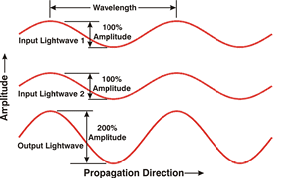
|
|
Converter:
Device that is attached between the television set and the cable system
that can increase the number of channels available on the TV set,
enabling it to accommodate the multiplicity of channels offered by cable
TV. Converter boxes are becoming obsolete as old model televisions
requiring a converter are replaced by modern televisions, which
incorporate a converter into the television directly. Also called a
set-top box.
|
|
Core:
The light-conducting central portion of an optical
fiber, composed of material with a higher index of refraction than the
cladding. The portion of the fiber that transmits light.
|

|
|
Counter-Rotating:
An arrangement whereby two signal paths, one in each direction, exist in
a ring topology.
|

Click to Animate
|
|
Coupler:
An optical device that combines or splits power from
optical fibers.
|
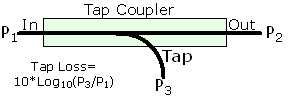
|
|
Coupling Ratio/Loss
(CR,
CL):
The ratio/loss of optical power from one output port to the total output
power, expressed as a percent or as decibels. For a 1 x 2 coupler with
output powers O1 and O2, and Oi
representing both output powers:
|
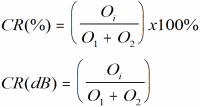
|
|
Critical Angle:
In geometric optics, at a refractive boundary, the smallest angle of
incidence at which
total internal reflection
occurs.
|
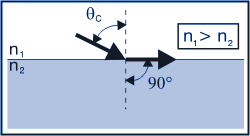
|
|
Cross-Connect:
Connections between terminal blocks on the two sides of a distribution
frame or between terminals on a terminal block (also called straps).
Also called cross-connection or jumper.
|
|
Cross-Gain
Modulation (XGM):
A technique used in wavelength converters where gain
saturation
effects in an active optical device, such as a semiconductor
optical amplifier (SOA),
allow the conversion of the optical wavelength. Better at shorter
wavelengths (e.g. 780 nm or 850 nm).
|
|
Cross-Phase Modulation
(XPM):
A
fiber
nonlinearity
caused by the nonlinear
index of refraction
of glass. The index of refraction varies with optical power level which
causes different optical signals to interact.
|
|
Crosstalk
(XT): 1) Undesired coupling from one
circuit, part of a circuit, or channel to another. 2) Any phenomenon by
which a signal transmitted on one circuit or channel of a transmission
system creates and undesired effect in another circuit or channel.
|
|
CSMA/CD:
Abbreviation for carrier sense multiple access with collision detection.
A network control protocol in which (a) a carrier sensing is used and
(b) while a transmitting data station that detects another signal while
transmitting a frame, stops transmitting that frame, waits for a jam
signal, and then waits for a random time interval before trying to send
that frame again.
|
|
CTS:
Abbreviation for clear to send. In a communications network, a signal
from a remote receiver
to a
transmitter
that it is ready to receive a transmission.
|
|
Customer Premises
Equipment (CPE): Terminal, associated equipment, and inside wiring
located at a subscriber’s premises and connected with a carrier’s
communication channel(s) at the demarcation point (demarc), a point
established in a building or complex to separate customer equipment from
telephone company equipment.
|
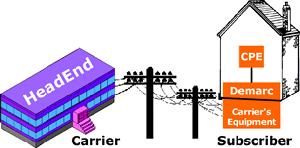
|
|
Cutback Method:
A technique of measuring optical fiber
attenuation
by measuring the optical power at two points at different distances from
the test source.
|
|
Cutoff Wavelength:
In
single-mode fiber,
the wavelength below which the fiber ceases to be single-mode.
|
|
CW:
Abbreviation for continuous wave. Usually refers to the constant optical
output from an optical source when it is biased (i.e., turned on) but
not modulated with a signal.
|
|
CWDM: see
Coarse-Wavelength-division-Multiplexing. |